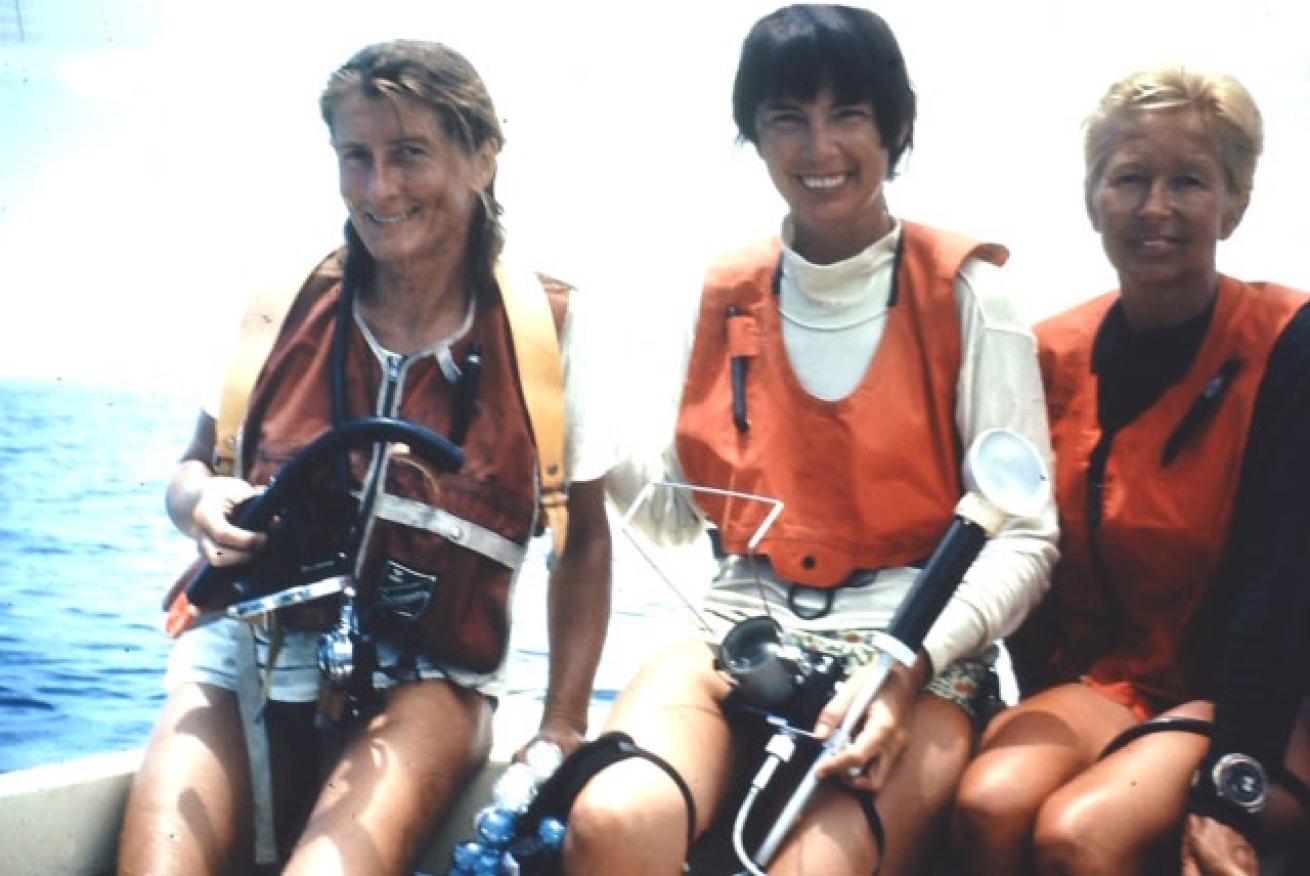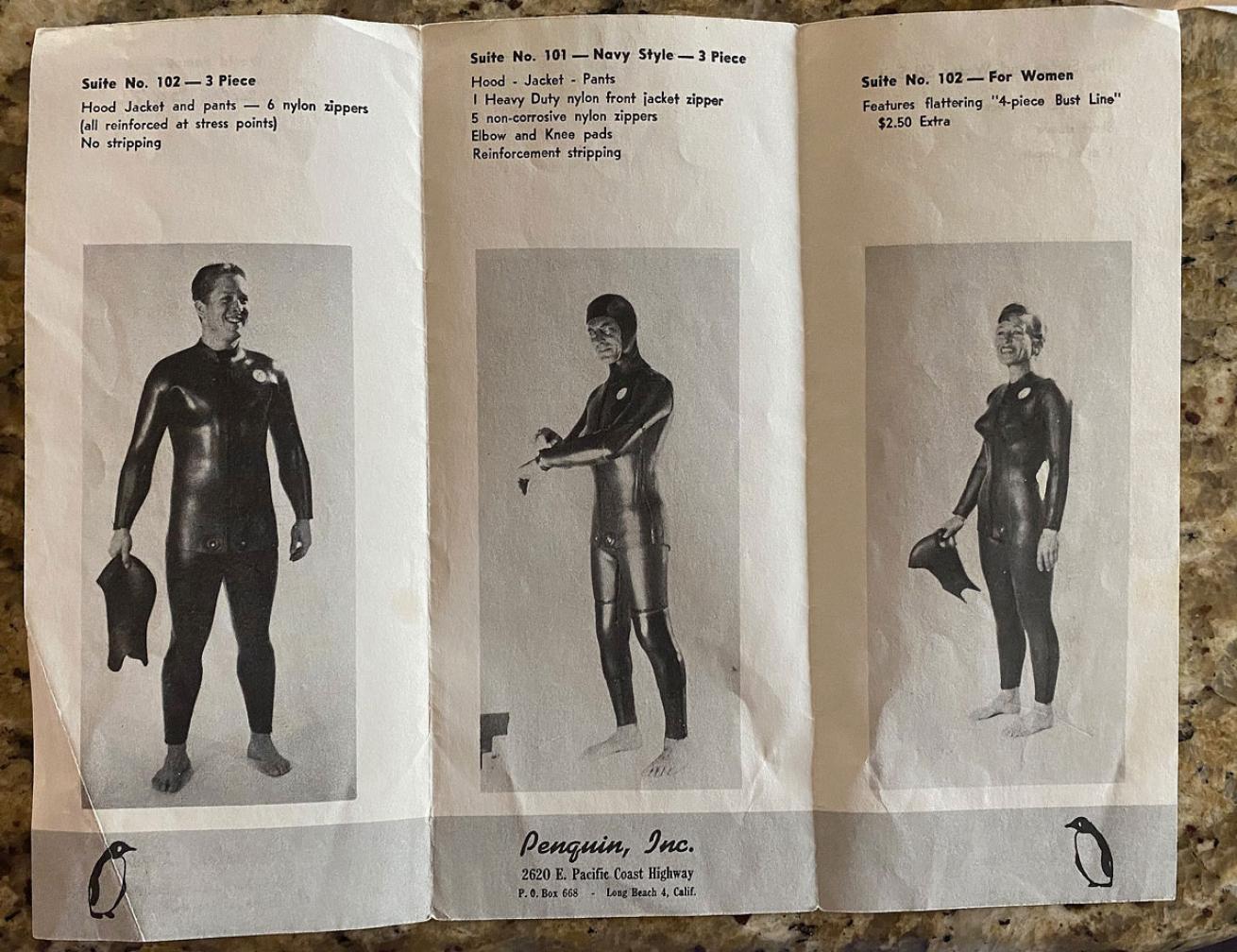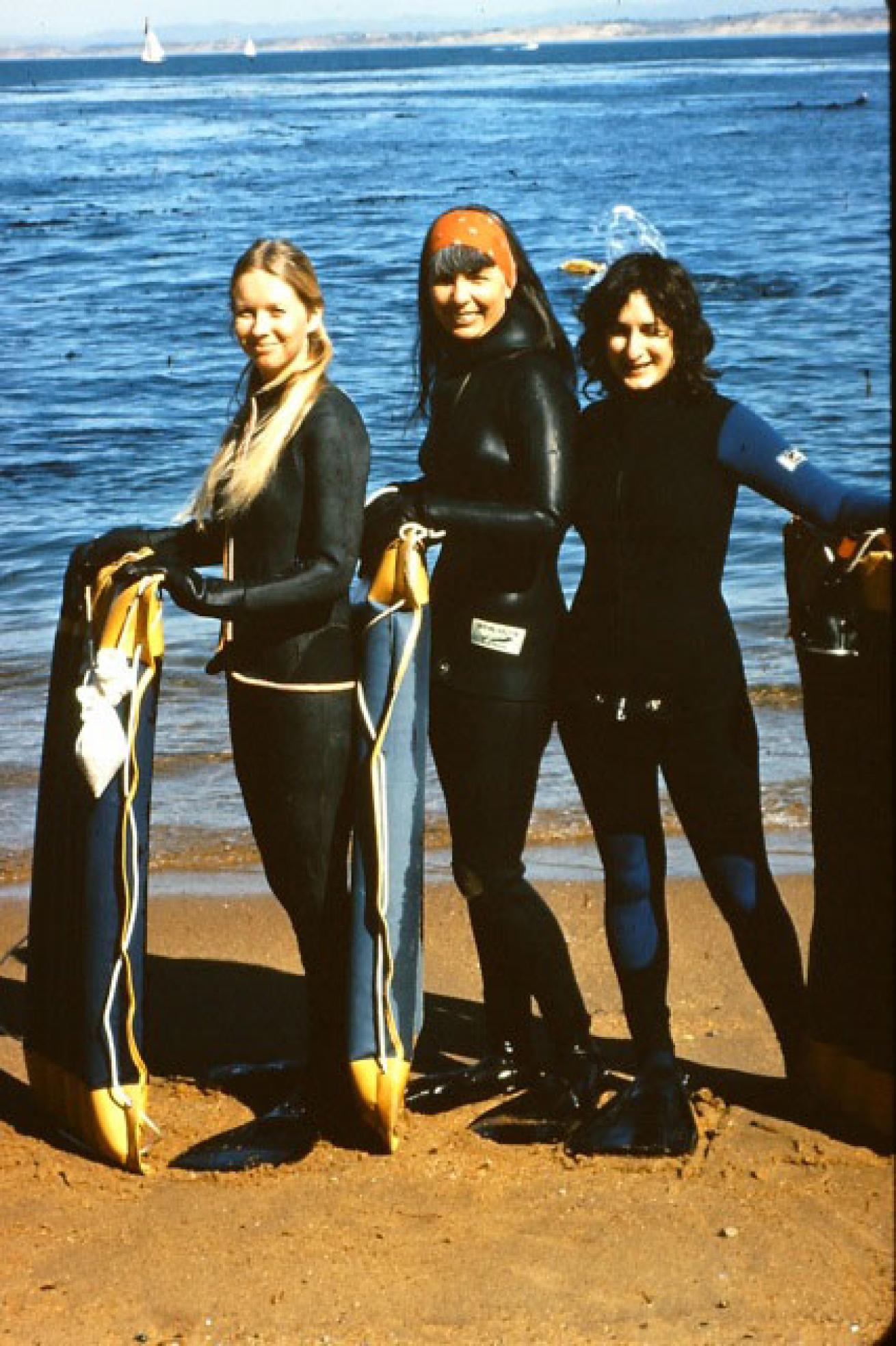The Mothers of Invention: A Brief History of the Evolution of Women’s Dive Gear
Let’s begin by being brutally honest about how unexciting this topic might seem at first glance. It’s the kind of subject that lends itself to facts, figures, and possibly a timeline with a bunch of arrows – all things that might bring back traumatic memories of your most-hated 9th grade class. Well, don’t worry. I’m not going there. This is dive gear we’re talking about, after all - covetable, empowering stuff that should never conjure thoughts of a middle school history class. Dive gear outfits dreamers, explorers, daredevils…and heroes.

Courtesy Barbara AllenBarabara Allen (middle) and Dottie Frazier (right) show off their Mae West BC's.
I was lucky enough to speak with more than a few of my personal heroines while researching this article, and their stories thrilled, frustrated, and inspired me. Just imagine: you desperately want to explore the ocean. You’ve made it beyond any bias that existed to gain access to your training – but the only SCUBA gear that was available was developed for someone twice your height and weight (and also lacking your curves). Throwing in the towel certainly wasn’t an option, so these ladies had a choice: create new gear or suck it up and figure out how to make the stuff that existed work for them.
I like diving in a sweater – said no woman ever
Perhaps the biggest hurdle women faced (and continue to face) is finding exposure gear that fits properly. This challenge was magnified in the early 1950s, when exposure gear for SCUBA was still in its infancy altogether. Instead of trying to fit into the expensive men’s rubber suits that were used by a lucky few guys, pioneers Dottie Frazier and Zale Parry cobbled together exposure gear out of wool sweaters or sweatshirts, long underwear, and wool socks so that they could comfortably explore the cold waters of Southern California. The first practical-use, commercially produced neoprene wetsuits were released later that decade; the suits weren’t designed for women, but at least they were accessible. However, since early neoprene suits were quite stiff and fragile, there was one glaring issue. Dottie Frazier, who’d long since become the first female scuba instructor and dive shop owner, summed it up succinctly: “I had a 42-inch bust,” she told me. “There was no way it was going to fit my chest. I took it apart and reconstructed it – this eventually turned into the first wetsuit pattern with a bra in the front.” Although it took several more years before wetsuits constructed specifically for women were popularized, they made an immediate impression on those who saw them. Barbara Allen, who graduated as a SCUBA instructor just after Dottie, said, “I’d been fitting myself into a two-piece guys’ suit for a few years, and then one day, I walked into (San Diego shop) The Diving Locker, and they were making suits with boobs in them! They fit better, and they just plain looked better. They were a custom-only deal in those days, and there were only a few places you could find them at the time.”

Courtesy Dottie FrazierDottie Frazier created the first women's wetsuit pattern. Frazier owned a shop called the Penguin where they manufactured their own wetsuits.
Over the next decade or two, wetsuits for women became more available, but the material remained unforgiving, and the sizing…well, let’s just say it was limited. Multiple women with whom I spoke were easily able to recall in detail any wetsuit that fit them well in the 1970s and 1980s – presumably because finding a wetsuit that fit was such a rare phenomenon!

Courtesy Barbara AllenBarbara Allen pictured in 1971 in her custom made wetsuit. Allen and friends get ready for a dive in Monterey, California.
Hyperbaric chamber technician, women’s gear expert, and instructor Lorraine Sadler told me, “First there were men’s wetsuits. Then came tiny wetsuits made for people with Barbie doll figures.” Photographer and conservationist Jayne Jenkins was equally descriptive, “Few wetsuits during the early 1980s fit. And if you could get them on, they were far too short - they’d reach to about my calf.” From all accounts, until neoprene suits incorporated some stretch (which happened in the late 1980s), custom wetsuits were often the best option for serious female divers. Editor and instructor Cathryn Castle remembers her first custom suit, a Fathom, fondly: “It made a huge difference in terms of my personal comfort in the water, as prior to getting that suit, I was stuck wearing generic black neoprene suits intended for men. This was a huge step forward.”
Totally full of air
If there’s one commonality to historical stories about buoyancy control devices, it’s that as soon as divers evolved beyond the “Mae West” (basically life jackets that predated the power inflator) and horse collar BCDs, everything quickly became…big. The Scubapro STAB jacket and other jacket-style BCDs that followed in the mid-1970s and early 1980s were intended to provide buoyancy to a huge range of divers – so women often wound up with far more lift than they needed (per Cathryn Castle: “It could have doubled as a four-person lifeboat.”). Lorraine Sadler agreed. “Nothing was small enough for me, and I often had even smaller female students, so I can’t imagine how they felt. The initial power inflators were as big as my hands.” Thankfully, BCDs became smaller throughout the mid-1980s, and the first BCD designed specifically for women, the Aqua Lung Elan (Formerly U.S. Divers), was released in 1988.
Big shoes to fill
If women’s wetsuits were considered a niche product, you can imagine how difficult it was for women to initially find drysuits that fit. Northeastern wreck diver Sally Wahrmann remembers her first drysuit in the late 1970s. “It was a custom-fit Henderson suit, but everything was big, especially the feet! The dump valve (designed to be fitted in the middle of the torso) was just not in a place that allowed me – or any woman for that matter – to place other gear over the suit properly. Finally, the staff at Henderson asked me to come to the factory, over 100 miles away, for a fitting. I drove down and stayed until the suit was fitted properly.” The large sizing of the feet wasn’t just a comfort thing - it was a true safety concern, as excess air spaces (especially those that are difficult to exhaust, such as the feet) can increase the potential for a runaway ascent. Lorraine Sadler found a crude way to get around this snafu with one of her early drysuits. “It was a great suit,” she said, “And it fit me pretty well, except that the feet were huge. I wound up using duct tape to compress the extra foot space.”
Faith Ortins, who co-owned Northeast Scuba in Massachusetts in the early 1990s, was keenly aware of the need for drysuits that fit women. “We were very dedicated to getting women into diving. Many of our suits were from Diving Unlimited International (DUI), as their crushed neoprene suit was the most popular one among wreck divers at the time. However, when we ordered them for our female clients, so many modifications were being requested that the production manager took notice.” Thus ensued a year and a half-long collaboration between Faith, some of the women who trained with Northeast Scuba, and DUI. The result? The first readily available line of drysuits cut specifically for women (1995). There was an immediate positive impact on business. “Half of our open-water students started training in drysuits, including an even higher percentage of women,” Faith told me. “And because we were keeping women comfortable, we kept women diving.”
“And because we were keeping women comfortable, we kept women diving.”
If you build it…
The industry took notice of the new customer base - and the increased sales that went along with it - and things shifted decidedly into high gear. Initially, however, many manufacturers placed their energy into making dive equipment that was (A) smaller, followed by (B) pink, a movement that imparted a sense of accessibility and fun to some women – but sparked a notable backlash from others. (The “shrink it and pink it” phenomenon of the 1990s was a topic of commentary from nearly every woman I interviewed.) Whether the trend was well-intended or not, some guidance was clearly needed. Fortunately, in the late 1990s, Lorraine Sadler teamed up with Jennifer King, the founder of the Women’s Scuba Association and WETT (Women’s Equipment Test Team), and the pair presented carefully crafted presentations at successive annual Diving Equipment and Marketing Association (DEMA) shows. By using the skiing industry’s success as an example, they provided insight and direction on the way that well-executed design (including color, I imagine) and technology would directly benefit dive manufacturers.
Since then, as Tanya Burnett has noted, “Fit, function and aesthetics have greatly improved, and I believe each manufacturer has taken these into consideration with their scuba lines, snorkel lines and wetsuit lines. Not everyone has created stuff perfectly, but attempts are made to appeal to female divers and their size ranges,” a statement I can’t help but agree with. My own gear collection, amassed over the last 30 years, contains a variety of equipment intended for all types of different diving pursuits; all of it is functional, and the majority of it is so comfortable that I rarely consider fit once I’m in the water – an outcome that Dottie Frazier and Zale Parry likely couldn’t have imagined when they first donned wool sweaters all those decades ago. Jill Heinerth and Renee Power, in their recent book Women Underwater, dedicate nearly 70 pages to detailing the vast gear choices women have today, but they also caution, “Our industry is only just beginning to recognize that women need distinct solutions for equipment rather than something that is simply made small and pink.” Exactly. For that reason, it behooves us to ensure that this recognition continues: by continuing to dive, by trying (and providing constructive input on) new gear, and – perhaps most of all – by continuing to learn from and teach one another. After all, it’s up to all of us to help guide the women’s gear of the future.
More Women in Diving
• Dream Chasers: Three Inspirational Women in the Professional Dive Industry
• The Sea Women of South Korea
• The Fantastic Grandmother's of New Caledonia
• Meet the First Woman to Dive All 50 States
• Badass Woman Dives All Seven Continents in Seven Months
• Becoming the Shark Lady: The Legacy of Eugenie Clark










